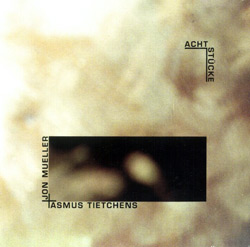
The approach used by Tietchens and Mueller in this recording involves negotiating at least a couple of potential stumbling blocks between the initial creation of sounds and the disc that the listener ends up hearing. In the first stage, Mueller excites various objects, here limiting himself to Chinese gongs and cymbals. This on its own can present a problem or two when encountered via recorded medium. In a live situation, a solo performer doing such with the imagination and force Mueller typically brings to his projects can incorporate the ambience of the room in which (s)he resides into the performance, allowing the listener to hear in three dimensions. Lacking a collaborator, the space can become a more than adequate substitute, particularly if one is free to move about and experience the overtones, shifting timbres and so on. When heard on disc, where the spatial element is absent (or thinned out due to the reproduction through speakers), there's a danger of each excitation tending to be heard more as an example: this is what happens when one attacks a gong in a given way. That can, of course, be enjoyable but a certain amount of environmental interaction is necessarily lost and the music can take on the aspect of a science experiment.
Here, Mueller's results were sent to Tietchens who used them as raw material and transfigured them through his own sensibility, adding a collaborative element but one at a remove (obviously) so that any give and take occurs in only one direction. This isn't a new idea and can be accomplished quite effectively depending on the musicians involved, their sensitivity, etc. but it can be a tricky business and, to my ears, the music contained herein only succeeds intermittently, rarely attaining the power I've heard previously in Mueller's music.
The enhancements Tietchens has made to Mueller's work are generally clear in that they are electronic in nature and are actually prominent enough that one is tempted to hear Acht Stücke somewhat more as a Tietchens project. On the opening track (the eight cuts are titled JMAT 8 through 15), Mueller's gentle metallic taps are subject to billowy reverb, effectively creating a hazy, fairly rich sound world. The "haziness" is the rub in the less successful pieces, however, sometimes verging toward the overly woozy. While this can still work on an individual track, over the course of a disc, a certain sameness sets in. At its worst, some loopy electronica finds its way into the proceedings (JMAT's 12 &13) causing one to wonder if Herbie Hancock circa 1972 had wandered into the studio. When Tietchens allows a degree of rough texture to remain in the mix the music benefits greatly, something that occurs about half the time here. For instance, JMAT 14 achieves a lovely, kabuki-like aura and the final piece evokes a fine sense of mystery, Mueller's scrapes tinged subtly and with care.
Comments and Feedback:



More Recent Reviews, Articles, and Interviews @ The Squid's Ear...


|

